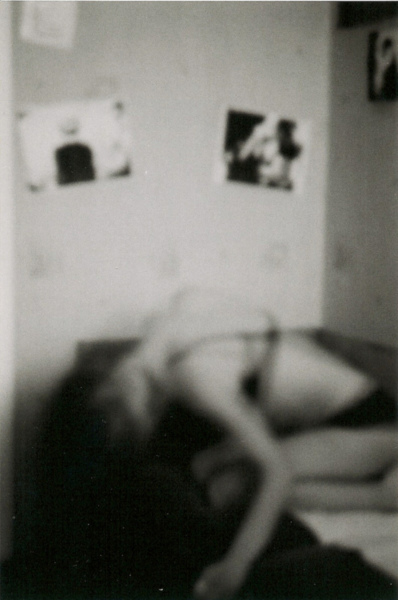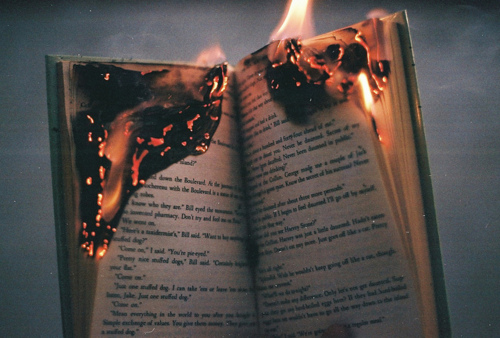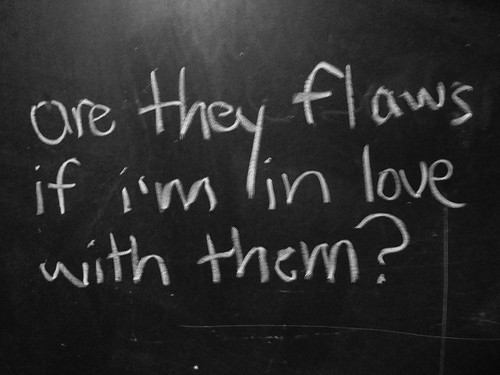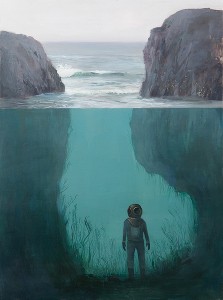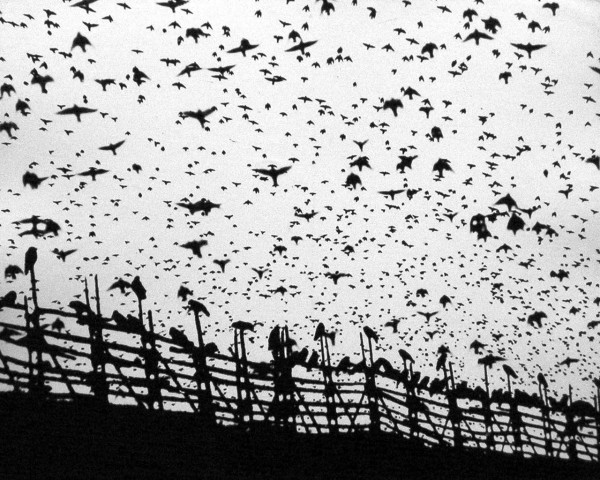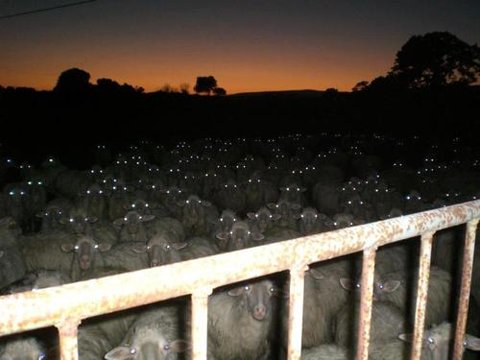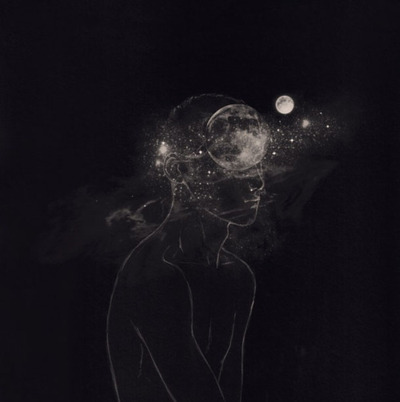
Gary Popovich : Lies My Father Told Me (an interview) (1997)
Gary Popovich wields his trademark Bolex like a switchblade, cutting out moments of everyday life with keen precision. But unlike other diarists, he is not interested in opening his private life to public discussion. Instead, he is engaged in a wrestling match with history. He feels that we are ghosts haunting machines of thought built long before our time, and which invite us to live only if we are faithful to the ideas of the dead. Popovich raises his hand against the departed, who appear in his movies like a procession of fathers. In his portraits of Irving Layton and Friedrich Nietzsche, and his travelogue about his father’s homeland, the former Yugoslavia, he grapples with the ruins of modernity. This mythic cinema would find its most compelling expression in his acknowledged masterpiece, Archeology of Memory (1992). Part home movie, part history of representation, its multiple picture rolls show a boy growing older amidst a teeming life of animals and passing landscapes, ancestors and friends. This simultaneity of consciousness, shown in cascades of overlapping pictures, is an image of memory itself. Like the rest of his cinema, it is a time machine that makes a lie of Nietzsche’s expression: that no one dies of fatal truths these days. There are too many antidotes.
GP: Sitting alone in my father’s hotel office, I would look out at Lundy’s Lane, a long row of Niagara Falls hotels, and wonder what it was like when it was a bush path the Natives used to take. That’s when I started writing poetry, though it probably sounded a lot like Hallmark cards. Later, at university, we studied all these dead poets, and I wondered about the ones still living, probably all working in hotels, writing up bills. Film seemed a way out of that. Although poetry created and inspired images, film could deal more directly with the world of pictures I was growing up in. I headed to Sheridan College in search of a technical education, figuring it offered the shortest program. I thought at some point you have to get out and do things because it’s a long exploration, this exploration of yourself.
MH: You made Layton Symphony (4 minutes b/w 1982) there, a film about Irving Layton which seems directly related to your interests in poetry.
GP: Layton came to the college to teach a course on modernity — how romantic genius, usually his, grappled with the Holocaust or sexuality, how the changing world affected the individual’s sense of a centered self. For me, Layton was a name on a bunch of books, a celebrity. Now I was riding the train back to Toronto with him every week while we read our writings. It was a way to make him more human and fallible, which was an important lesson — that my heroes were living, pissing, shitting human beings that could fall from the grace I’d bestowed upon them.
MH: How did you proceed with the film?
GP: That was difficult. He didn’t give me any time at all. He said if you want to film me you can do it before class one day, I’ll come in fifteen minutes early. The audio interview I did was about an hour, and the filming took fifteen minutes. I brought in images of Layton on video and filmed him looking at it, waving his arms around, talking as he’s watching himself. I put together a four-minute super-8 film, joining those images with the interview we did. But the images didn’t do much for me. A year later we learned about the optical printer and took hand-processing workshops. I took the original footage, blew it up to 16mm in six versions, hand-processed with different scratches, water blotches, and grain structures, and made the images dance to his words. I laid a piece of music over it. At the beginning he says, “I like to have a symphony being played when I compose, it helps to lubricate my thoughts,” so it’s as if the Mozart symphony is calling him to attention, organizing his thoughts, and then his voice erupts and the images sing along with the music for a four-minute bacchanalian foray into Layton’s image of himself. The film is called a symphony because Layton is a holdover from the last century, there’s something symphonic and grand about his way of thinking.
MH: The title seems ironic. This grand symphonic form has now become a scratchy, handmade film which works to deflate the myth of Layton. Because he’s insistently looking at himself, the subject of the film is really Layton’s image.
GP: Yes. He had great difficulty with the film. I gave him a private screening and as soon as the film was over he turned over and went to sleep, dozing on the floor. Total silence in the room. Very awkward. I heard later from his wife that it profoundly disturbed him, that he saw his own death in these images, that it seemed a memorial to him. He wasn’t too thrilled with it.
I was thinking about film only in terms of desperately wanting to make work, though not necessarily knowing why, having an incredible need to be a filmmaker. I was coming from a lot of uncertainty and insecurity in terms of being an artist. It wasn’t encouraged in my household. As a kid I was pushed to enter law, and business school was my compromise between my parents and my poetry. From business and law I went into literature, and then went to Sheridan to study film. Art didn’t seem like a legitimate activity, it was for charlatans and entertainers. My father had them in the hotel, and they were usually a bunch of bums according to him. They were r+b crooners who just wanted to drink, fuck, and lead an aimless existence. I was afraid of that but that’s what I wanted. I was in the dark about it for a long time, whether film was for me or not. But after school I went on the mandatory European tour. [laughs] I studied at an interdisciplinary arts program in Paris for a couple of months. There, art was legitimized, the state had buildings where art was honoured and “museumized,” so I came back with a lot more confidence and arrogance. What turned me on when I got back was feminist film theory, which became a way to talk to people. There was a desperate kind of loneliness driving that search, a desire for both something sexual and something intimate based on friendship. I didn’t talk very much, but I learned how to ask questions. The pretense is we’re going to talk about Laura Mulvey’s essay “Visual Pleasure and Narrative Cinema” but what we’d actually do is talk about each other. It was safe because I wasn’t on the make, I was making a film. The cock wasn’t going to get in the way. What I really wanted was to get close to people, to figure out my own sexuality. What’s the difference between watching a stripper or a lover? I was watching both. I wanted to talk to strippers. I wanted to go to therapy so I could fall in love with my therapist. I wanted to go to a bar and make a film with a stripper and maybe she would take me home and tell me secrets about her sexuality. In the film that came out of all this (Choral Fantasy 25 min 1985) there are three women and three men. The women appear throughout the film like a Greek chorus, one reads Mulvey’s text, and they arrest the flow of the narrative, just as Mulvey’s essay prescribes. The men propel the action, make deals, wander alone, confused, unable to say what they feel or mean. So it perfectly sums up where I was at the time.
MH: Is that why you pulled the film from distribution?
GP: I don’t mind showing the confusion I was going through at the time. But I don’t think the ideas and their expression have joined strongly enough to make it worthwhile for the viewer, so why burden them with it? It was a personal exploration. It’s possible that it will speak to me differently later and provide clues to what happened. But right now it doesn’t feel like it should be a focus of anyone’s attention. For similar reasons I’ve thought of pulling Self Portrait, I don’t feel it’s representative of where I’m at right now. But then they never are because they’re done, and you’re already moving on, creating someone else who looks at his past as a primitive and rather foreign relation. Can I stand to look at that level of immaturity? I’m not mature enough to stand that immaturity. Maybe in a couple more years.
MH: How did Immoral Memories 1 (10 min b/w 1988) begin?
GP: From the feminists I turned to reading Nietzsche, grappling with a strong figure who takes on the shallowness, the lies, the self, the people around him, all in a rigorous examination of his own emotions. I needed to build strength. I saw confusion. I wasn’t certain I was really onto something at all after my first films. Foucault said you don’t really study Nietzsche unless you become him and I did. I have black books full of notes in his style, yet his style was to say find your own style — don’t be like me, become yourself. I started by copying. I think that’s okay, to allow yourself to be taken over, to discover and identify what you need to give up. I imagined Nietzsche’s emotional turmoils as my own; they reflect maleness and the role fathers play. Wagner was a father he was moved to embrace and then rebel against — but it wasn’t clear that Nietzsche was a father for me, or that I was pursuing the same path with my own father. I needed to throw myself into conflict with these people to work it out. You need to see how ugly you can be, how much you’ll deny about your feeling. It’s like tearing apart a watch you can’t put back together. As a kid, I’d tear everything apart, needing to know how it all worked, what was inside. But I had great difficulty putting things back together again. It took a lot of hard years to start learning that process.
MH: After two years of reading you made a film without words.
GP: I wanted to grow as a filmmaker. If you’re a writer you have to deal with words, as a painter with paint. I knew that hiding behind books and dead people would only take me so far. I wanted to make a piece of music, using light and rhythm to relate the story. I wanted to convey a person’s movement through a pivotal moment in history, where the arrival of photography and cinema heralded an overthrow of humanism. The revolution wasn’t just industrial and technological, but metaphysical. My film is an ode, a Nietzschean dance of celebration in three parts, using his life as a structural bind. Immoral Memories begins with the early machinery of cinema — praxinoscopes, zoetropes turning — then Christ crucified, images from the earliest days of cinema, photos from Nietzsche’s youth and Muybridge’s motion studies of human locomotion. There’s an image of two men wrestling which I re-photographed to make it look like one is fucking the other up the ass, trying to suggest the sexual charge that informs male fraternity, trying to echo things in his life I was feeling. Churches, icons and heroes are “shaken” or ripped apart by camera movement, dismantling them as an image, as Nietzsche had dismantled them as ideas. The second movement depicts Nietzsche’s travels and friendship through the accelerating frenzy of train tracks, photographs of friends, pictures of objects such as Nietzsche’s typewriter, and two Muybridge characters coming at each other on horses. It’s like a convergence of lines that leads to obvious collisions. It also sets up the need for solitude and reflection, which is the tone of the opening of the third movement. Nietzsche spent a couple of years in Venice and Turin where I went to shoot the final section. Legend has it that in his last few conscious moments he was in his room in Turin writing when he heard, then saw below his window, a horse being whipped by its master. He charged down the stairs and threw his arms round the horse before falling down onto the cobblestones and lapsing into an insanity that would last a dozen years. That’s what I used to structure the final few moments of the film. When I arrived at his apartment there was a sign by his door that read “Cinema.” A block from the apartment is the fading Shroud of Turin. It struck me that the film was about this triangulation — Christianity and fathers; Nietzsche; and cinema. This very old representation of Christ, the fading metaphysician, was one block away from the anti-Christ physician of the modern, Nietzsche. And as darkness gathered around Nietzsche, a new industrial father, Lumière, was sending his camera operators around the world to begin new forms of worship. I took a Lumière film that showed the funeral procession of the assassinated American president, McKinley, the casket drawn by horses. I re-photographed the scene in close-up, until all that’s visible are the light reflections on the carriage as the funeral train pulls in, so that the last moments of the film are final glimmers or flickers of conscious perception progressing toward abstraction. The final title, “1900,” is both the year of Nietzsche’s death and the beginning of the new century. It’s an ode to the last century, a film that taught me how you can connect one image to another in terms of tonal quality, shapes, and forms, to crystallize emotional ideas as opposed to literary ones.
MH: How did Caress (1.5 min silent 1989) begin?
GP: I lived four years in my Lakeview apartment and every day I looked out the window at a tree. Then it was time for me to leave, to say good-bye. That was part of it, but also the blue sky, the buds, something about the silvery branches without leaves. I love trees; they seemed to be the only stable living things in the crazy hotel environment I grew up in. As a kid I wanted to live in a subdivision. I wanted to be normal. The time at the Lakeview apartment was my first sense of stability in Toronto. But I was changing again, about to move to a much less secure dive on Queen St. above a store in Parkdale. I suppose I needed to film the tree as a way of embracing it and carry part of it with me to the uncertainty that lay ahead. I shot four rolls of super-8, a frame at a time. In the pixillation, many of the individual frozen frames looked like the cave drawings I was studying, so once they were edited together there was this rapid procession of drawings that flickered in front of your eyes. It recalled generations of that tree, of representation, like an ode or a wave good-bye to something that was loved in the past. I was breaking up with Louise at that time, going separate ways in two weeks. I knew that wasn’t a healthy situation, I was probably feeling that I needed to embrace other things, not only in terms of dealing with her or other women, but needing to move outwards. That’s when I started working at the LIFT film co-operative, joining committees, trying to talk in ways she and I couldn’t. From then on, what was inside was going to have to come to the surface a lot more, so it wasn’t just about generations or the past, it was more about being able to say this is what I need to embrace now, it’s you, it’s the tree, it’s everything. Immoral Memories and Caress were ways to shake my body, to open it up, to embrace these things that my mind was just toying with for awhile. I was shedding a lot.
MH: This memorial uses an expressionistic camera rhetoric which conjures the outside as metaphor for interior necessities.
GP: Someone suggested once that Caress is an inappropriate title — it should have been Frisk. At the end we hugged and went away. It was a way of continuing what was happening in Immoral Memories, taking an emotional experience and translating it not with words or ideas, but allowing the ideas to become rhythms and compositions on their own and see what shape they can take.
MH: How did Elegy (21 min 1989) begin?
GP: I was travelling to Yugoslavia, my family’s homeland, and decided to take a camera and a tape deck with me. I was filming intuitively and whatever happened was fodder for what I imagined as a documentary of divisions — between Serbian and Croatian, father and mother, anger and sensitivity. I started shooting in Split, where the architecture’s been marked by four distinct periods. The Roman emperor Diocletian had a palace there, the Byzantines left their mark, as did the Venetians and others with Romanesque styles, and now there are modern apartments set into the ruins of palatial walls. In a single wall you could see each of these periods, parts would be broken off and rebuilt into a palimpsest of remnants set in jarring relation. It seemed like a metaphor for Yugoslavia and how I was feeling at that time. My father was travelling in Europe at the same time, my sister and brother-in-law too, all travelling separately until we converged in a mountain village in Yugoslavia, at my uncle’s. We’d wander round the mountain, see the place where my father tended sheep, picked chestnuts, and drew water from the spring. It was a way of getting a sense of his past. But the present was always ruining his stories. Everything he’d talked about had changed. Instead of seeing this wonderful idyllic river, I’d be looking at a stream that was a few inches deep with old fridges, stoves and garbage dumped in it. It drove him nuts. He got into arguments and fights: “This is shit! You’ve let this country become a junk heap, a pigsty!” For me it was just a different place I wanted to explore. So we walked on. Following his past. Chris and Jim left after a few days, I was leaving for Greece soon. Then someone brought a message to my father about a friend of mine back in Canada. When I got out of the shower my father came into my bedroom and said, “Shawn’s dead.” We looked at each other for a few minutes. Is this real? Is this true? I didn’t believe it. I thought it’s not Shawn, it’s Ticker. Ticker wrapped himself around a pole, he was drinking. Shawn couldn’t die. He was okay a week ago. He was coming up to Toronto for his chemo so there was no way he was dead. It was someone else. That’s what I believed for the next five days, still knowing it was probably him. I was paralyzed. My relatives said, “Well, that happens. Do you want some yogurt?” I was confused and angry that no one could talk about it, but what did I expect? I hardly knew them. So I took my camera and just wandered all over Skopje where everything shook with its own history. Like the Turkish fortress, which is a tourist site now, but for me became a warning of future wars. I was in shock, confused, five thousand miles away, surrounded by all these reminders of death, with no way of sharing what was going on inside me. A group of kids called me over to take their picture, Muslim boys. I’d been shooting churches and mosques, rewinding the camera to set one image overtop another using some planning and lots of chance. It was a way of working architecturally with layers of images inside the camera, of allowing the camera to show this history of layers. I shot the boys, rewound the film, and then shot a Serbian church which cuts through the image of the boys, burning their image out. Which is exactly what’s happening now. The Muslims are being wiped out by the Serbian Orthodox church. All those wars have begun again.
Elegy runs through three movements. The first shows a passing landscape slowed to different speeds, fields with haystacks and houses in beautiful greens and yellows overlooked by mountains — that seemed an opening for me, a way into this country, this past. Folk music from the villages plays while my aunt reads my coffee cup grounds. Her reading was a troubling list of opposites, “Lots of friends but at the same time emptiness and darkness. Your road is long but your road is empty. There’s a message coming over here on your masculine side. But over here on your feminine side there’s something nice going to come.” Intercut with the landscape are glimpses of statues, architecture from Split, and people from the village. It’s a portrait of this fragmented country, the ghosts, Shawn’s death, a portrait of myself being split, my doubles loosed on the landscape. The first movement ends with water flowing into barrels, and my voice-over intoning, “Hopefully when I get through this I’ll be able to cry.” The second movement begins with family documentation and ends in reflection. A little girl recites a poem about the partisans slaughtered by Bulgarian fascists, as she sits in front of the partisan monument. My father recalls a childhood friend dying, crying as he holds his portrait. There’s a family picnic and then a movement up the mountains, an attempt in voice-over to conjure the join between sound and image: after Shawn’s death these relations seemed arbitrary, the pull from one moment to the next another chance procedure. History’s rewritten until you can’t hear anymore the echo of things long past. The second movement closes with water pouring over a vast wall. I imagined it like the wall of a cinema and wrote: “Fate weaves its light, casting monuments of moving images. The picture screen unfolds to drape an empty wall and when it’s over rises up to set itself beside its own nature.” That seemed the function of art, as a model or mirror. The final shot returns to water with deeply buried branches moving underneath the surface. With the sense that there’s something more, something that can’t be said, or won’t. Not yet.
Three days before I found out about Shawn’s death, my father told me about a friend of his who had died — they didn’t get him to the hospital in time. He was nineteen years old. I thought that was an incredible coincidence that he’d lost someone coming to Canada, and I’d lost a friend here. His story begins the third movement which is shot in black and white and gold. Begun with a look inside a house, it moves outside as his story ends, unable to reach out and touch his friend. A terrible wail begins, the mourning howl of the Serbian women, which lasts until the film’s close. We see a woman lighting a candle for her dead brother, it’s one of those chilling moments — she was willing to give me anything, looking at the camera like, “Do you want more?” and I keep it running, and she turns to the monument, and embraces it. It’s one of those things you deliberate over for a while — do I leave this in? Is this too raw and revealing? But it was so touching. The last image of the film looks like a tombstone except it has a spout in its midsection, with mountain spring water issuing. This seemed to sum up the film, it was an image of both sides, life giving and death recalling. I suppose I mediated my feelings about Shawn through the film during the four years I took to make it. A year after it was finished, in 1990, I was invited to show the film in a Swiss festival. A French translation was sent to my hotel room and as I read it, I started crying. I received money to finish a film and travel with it because of Shawn, it was the most puzzling thing that I should benefit from his tragedy. You can juggle the personal tragedy and the beautiful sunny day but, under all these images, under every cut, is Shawn’s death. For me, film was a job, I wanted to become a filmmaker, but not till that point did real life arrive. I lost this wanting to become a filmmaker. Now it was a way of life. That moment in the hotel room shook me. That’s when Shawn died for me, and everything changed.
MH: The next film you made, Antigone (8 min b/w 1990,) also relates to death.
GP: Antigone is about trying to bury something that won’t go away. We were shooting a retelling of the Oedipal myth, and I thought that everyone, experienced filmmakers, the Canadian film industry, everybody’s still dealing with the old story. Maybe you should comment — it was your idea.
MH: I wanted to make a diary film using several image rolls printed together. The first roll would be like a stencil, a high contrast print that all the other pictures would appear inside, and I figured what better for a stencil than the Oedipal myth, patterned imprint of unconscious ideals. So I asked you and Barbara Sternberg to act it out with me, and Steve Sanguedolce to shoot it.
GP: I decided to bring my camera along and shoot in between takes, when there wasn’t any action happening. I thought I’d shoot first and ask questions later — if a film came out of it fine, and if not, that was okay too. It begins on a rooftop with four of us walking around in slapstick fashion and the voice-over announces, “This is the Ex-Patras studios of Hollywood North… Here they meet to bury a ritual…if they can…the story that unfolds in one’s sex; the one that presents violence in genitalia and love of the classics. As with any good story, at the end of this one there will be bodies to bury.” Shots of the production follow, much of it rendered in a farcical way. But the film was a serious attempt to deal with Canadian cinema, how the people who came before us affected our own, how the past eats the present. The final shot shows us piled in a heap of bodies while the witness circles and the voice-over says, “But these ex-patriate experimenters are retiring this tired old story. It is too confusing when actors play too many roles that always amount to the same thing. They have taken the door of the father and refused to breathe more life into this eternally recurring fairytale. Here they lie waiting to be buried; here, at the crossroads of nature and history, the Canadian Shield and Hollywood North, documentary and fiction, Queen Street and Bay Street. And what rough cinema, its hour come round at last, slouches towards Toronto to be born?”
MH: Do you think an avant-garde exists?
GP: I’m not part of an avant-garde. That was an important term when we were starting out. I don’t see what value it has anymore. It was important to study those events, it gives you a sense of belonging to that long line of history. Perhaps the term characterized our idiosyncratic curiosity and risk taking in filmmaking and gave us a sense of security against “mainstream” audiences and critics who seemed indifferent to us. I guess there’s still safety in numbers.
MH: What about the audience?
GP: A few years ago I thought audiences didn’t matter, that it’s not about what others bring to your work. Now I really believe it. For me the communication isn’t with my audience, it’s with my tools, my medium. It’s become most meaningful to me to pursue an exploration of who I am. The self is such an infinite layering. I can’t be turned on by many of the cinemas around me. I used to have a lot of anger over what films got made. But this anger is also turned onto my own work; often I think it’s a bit shallow, that it needs to go further, whip myself. And that’s good. As my desires and interests coincide with others, my work reaches more people. I’m doing exactly what I want to do in film and it’s still fun, even though the motivating factors are purely ones of exploration. I don’t need to be avant-garde and attack everything. I know that’s a kind of posturing or stance.
MH: Tell me about 33 (3 min 1997).
GP: I was 33 when I shot it. Those two numbers are infinity with a bit missing. It was my birthday. I’d spent a harrowing night reflecting on my past and threw the I Ching with three pennies chosen at random, each with different dates. Each date corresponded to a grouping of three friends, at three very different times in my life. I never had any brothers, except for them. One was already dead; another was sick. And I started feeling the fragility of life, I was shaking with tears and tried to write. I turned on the tape deck and mumbled for an hour-and-a-half, finally picked up the camera, and went for a walk. 33 begins in my apartment with the three pennies in my hand, then moves to a hydro pole and wires, then to a church with stained glass windows — two different kinds of power. I filmed some very old people, many in wheelchairs with young kids racing around them. My nerves were right on the surface, I was feeling everything. I just wanted to protect the world and I channeled all this through the camera. I photographed layers of stone tracing generational lines, then the movement of light through trees, another image of generations. I filmed my journey through a park, busy intersections, past fences, bunches of flowers, to the lake where silhouettes pass back and forth in quick, ghostly glimpses, and a sunset sinks on the horizon. I asked John Black to make the soundtrack. I described the film in terms of an emotional progression. There are different forms of energy expressed — the spiritual energy which propelled it; light energy from the church; the motorized energy of the children. I told him what that meant to me, and he composed a track using his own electroacoustic sounds. It was another wordless exploration, and summed up a stage I was going through. I was trying to find a structure that expressed the fragility of life. It’s easy to see now that people are dying, but back then… I wasn’t going to let the world affect me because I needed to protect myself and stay alive. To be vulnerable is insane. I didn’t know that’s how you have to grow. But you need something to anchor yourself. I was finding it in isolation or books of the dead. The groups of three helped that day. Those two years in Parkdale were harrowing because I’d opened myself up, but didn’t have a home, a place I could return to find myself.
Archaeology of Memory (14 min 1992) began in December 1985. I was doing some pans along the lake. I shot off eight rolls of black-and-white high-contrast film and processed it myself. I was studying the pan. What does it mean? How do I use these tools? It was an experiment. But what did I hope to discover with this? Eight rolls of pans across water? It was very strange. I processed it all. Seven rolls were fine. One roll was empty, black except for the swirling grain and scratches. I threw away the seven rolls and looked at the scratches over and over, thinking that they looked like cave paintings from forty thousand years ago. That began the process of finding out how these early forms of representation narrated the condition of my own life, the way I was marked. I jumped into the skin of what I was exploring, I started living in those times. I imagined how people communicated, living at the mouths of caves, and travelling deep inside them to perform their rituals with torches, shadows, music and masks — a lot like cinema. I started arousing those states which led me to an archaeology of my own family history. Old home movie footage my parents had shot. Then I started gathering animal images. Animals are part of an evolutionary strand that we belong to. “Animal” is an echoic word that replicates meaning in its pronunciation, it means breath or soul or spirit. This led to sexuality and all the other forms of energy that we witness and contain. That’s what would hold these threads together. At the time I was very confused about sexuality and its representation. I wasn’t sure what gave me pleasure, what I was afraid of — men? women? And then I met Lisa, who was exploring the same ideas — sex, power, politics, aggression, tenderness, pain, pleasure. We talked naked for a year. We’d get together, have our clothes off in minutes and talk. That’s when sex became less of a mystery. But there was still a question of its doubling, its representation. How do you shoot this? Much of these explorations became part of Self Portrait, while the actual sexual representation became a form of energy in Archaeology, explosions of light, heat, intensities, and chemical reaction. All of these elements, home movie images that revealed the patterning of social structures and stereotypes, the animals, sex and landscape were woven together, laid overtop one another to make Archaeology of Memory. Randy Smith and I talked about the musical aspects of the film over seven years as it evolved, then he composed an amazing musique concrète piece that really punctuates the humour in the film. It’s an interpretive work that’s very precisely measured and intricately woven, like the images.
From the outset, I’d intended to make a film in two parts — the opening would be Archaeology, and the second part called Self Portrait Taking Stock (72 min 1992). Both films took seven years to figure out. Self Portrait was an expression of a time where some of the most fundamental changes in our country occurred, not only our identity as Canadians, but the future of how we might live together was being debated. It was an important part of my own identity. I grew up knowing I wasn’t a WASP, I wanted to live in the suburbs with a normal name. Now difference is being celebrated a lot more. Thirty years ago it was different. You identified with the British establishment. Especially in a small town like Niagara Falls. Now all that’s started to change and occasioned an identity crisis in all of us I think. Self Portrait was a way to grapple with what was happening in the country, the film co-op, my neighbourhood, my relationships, my body. Along the way I made over 250 personal tape recordings — telephone messages, parties, conversations with friends, personal musings, television and radio. Maybe twenty-five hours of diary images. The camera and tape deck were with me all the time. Three years into the film I figured what it was about, in a night I called the sermon on the toilet. It was one of those harrowing nights of introspection and self analysis aided by drugs. Sometimes you need those things. At other times just a prayer will do. Please let me see this clearly. That night was the middle of the project and I sat in my washroom for six, seven hours looking at the cleanliness of the things we use, the places we send stuff from our bodies. I thought about how my parents prepared our house, how certain parts of the body are hidden, how we hide from each other in this architecture of the invisible. Why does this washroom have to be so clean? Then I knew that the film had a spine that held it together, patterns of interest and development, and that in order to go on, I needed to break its back. That’s what I set out to do. After that it was, “anything goes,” don’t worry about how you look or feel — expose yourself. I broke it slowly over the next three years, three new years of gathering, and after six years I had a lot of broken pieces. So what was all this? Well, it was the process of breaking its back, which I had to reconstitute and then show how it was taken apart. That’s what the film shows.
Re-united with Archaeology, it begins with a mythological expression of beginnings. After this storm of animals and sex and water, Self Portrait begins with an image of the universe, no bigger than a baby’s hand, published in Maclean’s magazine. It begins again in my childhood, with home movies, audio recordings of me as a child pretending I’m a DJ, showing how this child absorbed the outside, and how this progression becomes family, and then community and then a country. Its midsection deals with the fractious film community, showing how I was broken by it, and then a gallery of friends in an extended train metaphor, sometimes meeting, sometimes colliding. That was the beginning of healing, to know my part in it all. The film converges in the figure of the self, stuffed with the flotsam and jetsam of pop culture, images of myself in the mirror montaged with the Wizard of Oz and Batman comics and a litany of radio voices. That’s the real film, that’s Self Portrait, and everything around it was a tracing of how I’d arrived there. After the mirror phase, there’s a refiguring of the personal and political, which makes sense because it’s coming from a reconstituted self, one that makes connections with the world. Oh yes, and of course it ends with the O Canada sign off. Self Portrait and Archaeology began in 1985 and the time of their making, from 1985 to 1992, represents a period that’s over now. It was a period which explored myself using the diary form in an obsessive and documentary way. Needing to understand the relation between intimacy and technology, between the needs of the looker and the subject. All that’s over now but you know how it is, repetition is a form of change. My father always told me that if you haven’t made it by the time you’re thirty-five you never will. I’ve just turned thirty-eight. And I feel like I’m ready to begin.
Gary Popovich Filmography
Layton Symphony 4 min b/w 1982
Choral Fantasy 25 min 1985
Immoral Memories 1 10 min b/w 1988
Caress 1.5 min silent 1989
Elegy 21 min 1989
Antigone 8 min b/w 1990
Archaeology of Memory 14 min 1992
Self Portrait Taking Stock 72 min 1992
33 3 min 1997
Originally published in: Inside the Pleasure Dome: Fringe Film in Canada, ed. Mike Hoolboom, 2nd edition; Coach House Press, 2001.
